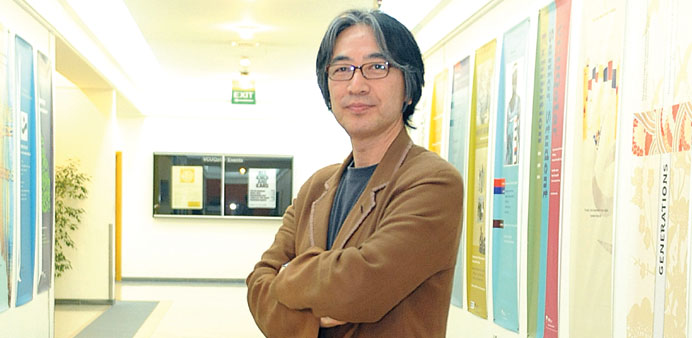By Anand Holla
In 1994, the London design museum asked South Korean industrial designer Byung Soo Eun to send 20 designs that can be shown at their Asian design week. “I was really excited. But I ended up sending nothing,” he shrugs.
A long, contemplative look through his works made Eun realise that none of his works really had a distinct identity. “Nothing set my designs apart from products that were designed in, say, Japan or Germany,” he says. This realisation would become a catalyst to Eun’s triumph in executing contemporary designs that originate from traditional culture.
Starting out in 1989 designing TV sets for LG electronics, Eun opened Korea’s first industrial design studio. The firm, 212Design Inc., successfully pulled off designs for everything from computers, phones, toys, refrigerators, to water purifiers. “Now there are more than a 100 firms there,” Eun smiles, who had recently come down to deliver a lecture titled “Design Beyond Tradition” at Virginia Commonwealth University in Qatar.
Industrial design is essentially about developing concepts that optimise the function, value and appearance of products. But back in the day, Eun worked his fingers to the bone to get his due. “People then didn’t realise the importance of design, and wouldn’t pay us well. So in the first three years, we kept promoting the worth of our work,” he says.
Have things changed with time?
“Of course. Consider two computers with same specifications. The plain jane-type costs $100, and the good-looking one is for $200. Earlier, people would straightaway pick the first option. Today, the majority buys the latter. That’s the power of design.”
Of all the lessons, Eun remembers one line that his professor would return to – one should design only for the customer. “Not for the money, not for the company you are working for, but for the customer. The most important factor is soul,” he says.
To tap into this soul, the source of inspiration must be pure. The genius lies in taking a wholesome look at traditional cultures, and not be limited to shapes or appearances, believes Eun.
“The modern designer must observe the functions, purpose, and lifestyles of the indigenous culture, and analyse them to create new designs. The catch lies in processing the culture’s richness and interpreting it as creatively as one can,” he says.
That’s what Eun did in 1996, when he began working on his own brand VIUM – a combination of craft and industrial design that featured products like bowls, ceramics, trays, wooden clocks, and furniture. “I worked on VIUM for five years, and launched it in 2001 to great results. For an industrial designer, maintaining the balance of aesthetics and functionality is most vital,” he says.
Predictably, functionality varies across the world. Eun mentions the vast difference in the refrigerators and washing machines that are made for Korea and the US. “Korean home appliances are better defined in their features and specifications. In Korea, the refrigerator is thoroughly organised with detailed segmentation and specific cabinets for vegetables and kimchi (a Korean side-dish made of pickled vegetables). The temperatures are detailed as well. Such detailing is a clear demand by Korean housewives,” he laughs.
The style though must not be sacrificed. Referring to a recent project that his firm handled, Eun says, “A client may want a dozen things but I must set the bar on style. For the lobby of a Korean bank, they wanted us to ape the Western interiors. I told them there are several buildings around the block that have the same décor. If you want to look contemporary, let us show you some options. We gave the lobby a modern treatment, but by sticking to traditional Korean concepts.”
It may sound like standard procedure, but Eun prides on his approach of persistence until the client understands his view. He says, “That’s important because your work must reflect your identity.”
Recently, Eun designed furniture inspired by Korean traditions, such as chairs, tables, and wine decks. “This year, I have an exhibition dedicated to this.”
There’s another reason why Eun is interested in reviving furniture. “Fifteen years ago, the Korean furniture industry was flourishing. But with European designs dominating the high-end furniture, and the Chinese goods flooding the lower-end market, most Korean carpenters are shutting shop. A critical factor here is that the Koreans don’t have their stamp,” Eun points out.
This worrying trend made Eun turn to the past. “Two hundred years ago, Korea was coming up with some amazing furniture designs. That’s why we are revisiting them and contemporarising those concepts,” he says.
Eun is a man of many hats; he helms exhibitions, is currently revamping an old market while retaining its old-world charm, and has been an artistic director of Seoul City.
His 212 Design Inc. was the star of the exhibition The Vernacular Mirror: Twentieth-Century Design, which was a major event during ICSID 2001 in Seoul.
His firm EUNcouncil has worked on projects like the Gwangju International Design Biennale 2009, and an exhibition of Korean craft “Hidden Match” in Riyadh.
Of the Riyadh meet, he picks “exchange of cultures” as the highlight that deserves to be emulated. “Since Korea has very skilled craftsmen, Saudi Arabia asked the Korean government to exchange craftsmen. Ten Saudi nationals came to Seoul to learn Korean craft and culture, and vice versa. Now that’s a great way to exchange craftsmanship and culture.”

Byung Soo Eun
